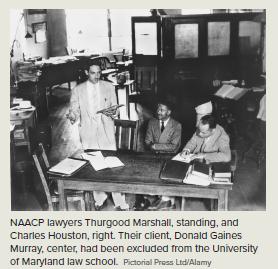Today, we often take racial, gender, and religious equality for granted. But equality was not always the
Question:
Today, we often take racial, gender, and religious equality for granted. But equality was not always the norm in our nation. In 1896, for example, the U.S. Supreme Court decided the controversial case of Plessy v. Ferguson. 20 The Court not only established the separate but equal doctrine in this infamous case; it also effectively ratified the evil of racial segregation in public schools as well as privately owned facilities.
Lawyers for the NAACP, however, devised an ingenious legal strategy to overturn this nefarious precedent. Instead of challenging the separate but equal doctrine directly, the NAACP decided to pursue an equalization strategy. Because segregated schools
rarely received equal funding in many parts of our country, the NAACP filed lawsuits demanding that facilities provided for black students be made truly equal to those reserved for white students.
In addition, the NAACP adopted an incremental approach to legal change. It initially sought to equalize professional schools for graduate students, not all public schools for all children. Lawyers for the NAACP decided to pursue this indirect legal strategy for two reasons. First, they recognized that the Supreme Court would be reluctant to overturn one of its own decisions, and, secondly, they knew that those states that practiced segregation in graduate education would not be able to afford to maintain separate black professional schools that were truly equal in quality to those available to white students.21
Led by Charles Hamilton Houston and his former student and protégée, Thurgood Marshall (who would many years later be appointed the first African-American justice of the U.S. Supreme Court), the NAACP won several early cases using this legal strategy, including Murray v. Maryland (1936),22 which resulted in the desegregation of the University of Maryland School of Law, and Missouri ex rel. Gaines v. Canada (1938),23 in which the U.S. Supreme Court ordered the admission of a black student to the University of Missouri Law School. Then, in 1950, the NAACP won cases that struck down Texas and Oklahoma laws requiring segregated graduate schools in Sweatt v. Painter24 and McLaurin v. Oklahoma.25 In those cases, a unanimous U.S. Supreme Court held that the Equal Protection Clause of the Fourteenth Amendment required those states to admit black students to their graduate and professional schools.
These decisions eventually paved the way for one of the NAACP’s greatest legal victories in its storied history: Brown v. Board of Education,26 decided in 1954. In this landmark decision, the U.S. Supreme Court repudiated the last vestiges of Plessy, holding that segregation in public education, even when the facilities are equal, violates the Equal Protection Clause of the Fourteenth Amendment as a matter of law.
CRITICAL THINKING QUESTION
Why did it take the U.S. Supreme Court so long to repudiate the doctrine of “separate but equal”? In your opinion, is the slow nature of judicial decision making a “bug” or a “feature” of our legal system?
Step by Step Answer:

The Legal Environment Of Business A Managerial Approach Theory To Practice
ISBN: 9781260247800
4th Edition
Authors: Sean Melvin, Enrique Guerra-Pujol





